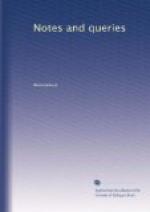If the prophecy attributed to Mahomet be not a fabrication of after times, it is strongly corroborative, and goes to show that he was himself acquainted with the practice of smoking, viz.
“To the latter day there shall be men who will bear the name of Moslem, but will not be really such, and they shall smoke a certain weed which shall be called tobacco.”—See Sale’s Koran, ed. 8vo. p. 169.
Query. Is tobacco the word in the original? If so, it is a stumbling-block.
Lieut. Burns, in his Travels, has the following curious statement:
“The city of Alore was the capital of a great empire extending from Cachemere to the sea. This was conquered by the Mahomedans in the seventh century, and in the decisive battle they are reported to have brought fire, &c., in their pipes to frighten the elephants.”
Lieut. Burns conjectures that they must have smoked bang, &c., tobacco being then unknown.
Buchanan’s account of the cultivation and preparation of tobacco in Mysore, carries with it a conviction that these elaborate processes were never communicated to them by Europeans, nor brought in any way from America, where they have never been practised. They strike one as peculiarly ancient and quite indigenous.
The rapid dissemination of tobacco, as also of forms and ceremonies connected with its use; its already very extensive cultivation in the remotest parts of the continent and islands of Asia, within a century of its introduction into Europe, amounts to the miraculous; and particularly when we see new habits of life, and novelties in their ceremonies of state, at once adopted and become familiar, to such otherwise unchangeable people as the orientals are known to be. Extraordinary also is the fact that the forms and ceremonies adopted should so precisely coincide (in most respects) with those in use among the American Indians, and should not be found in any of the intermediate countries through which we must suppose them to have passed. Who taught them the presentation of the pipe to guests, a form so strictly observed by the Red Men of America, &c.? But the “narghile,” the “kaleoon,” the “hookah,” the “hubble-bubble,” whence came they? They are indigenous.
Great stress is laid on the silence of Marco Polo, Rubruquis,—the two Mahomedans, Drake, Cavendish, and Pigafelta; also of the Arabian Nights, on the subject of smoking,—and with reason; but, after all, it is negative evidence: for we have examples of the same kind the other way. Sir Henry Blount, who was in Turkey in 1634, describes manners and customs very minutely without a single allusion to smoking, though we know {156} that twenty years previously to that date the Turks were inveterate smokers. M. Adr. Balbi insists likewise on the prevalence of the Haitian name “tambaku” being conclusive as to the introduction of tobacco from America. This, however, is not exactly the case: in many countries of the East it has vernacular names. In Ceylon it is called “dun-kol” or smoke-leaf; in China, “tharr”—Barrow says, “yen.”




